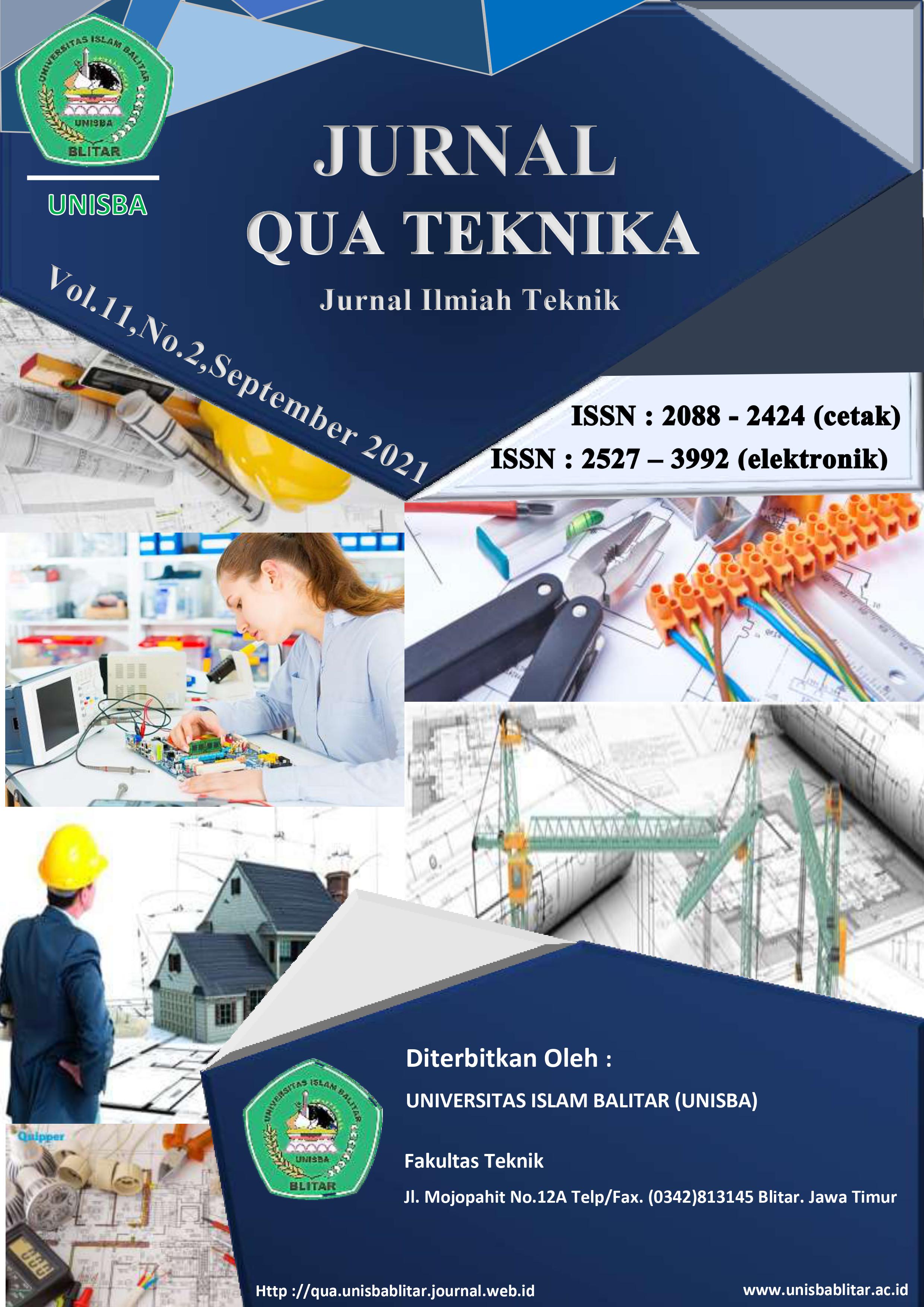PERANCANGAN ALAT KESEHATAN WIRELESS BODY AREA NETWORK MULTISENSOR BERBASIS APLIKASI ANDROID
DOI:
https://doi.org/10.35457/quateknika.v11i2.1636Keywords:
Body health, Wireless Body Area Network, Prototype, MonitoringAbstract
In this study, we designed a multisensory medical device to carry out a process of monitoring body health that was integrated into the system so that the patient's health could be detected. This tool uses Wireless Body Area Network technology that can work with Android-based platforms in real time. In designing this tool, it is designed to detect body health automatically by displaying information about body temperature, blood pressure, heart rate and oxygen levels in the blood, then sending notifications to the server without wasting time, and recording physical health information data automatically. Real-time display on the smartphone, owned by the user and provides a readable body health status that is healthy, an indication or needs action.
References
N. Bui, M. Cesana, S. A. Hosseini, Q. Liao, I. Malanchini, and J. Widmer, “A Survey of Anticipatory Mobile Networking: Context-Based Classification, Prediction Methodologies, and Optimization Techniques,” IEEE Commun. Surv. Tutorials, vol. 19, no. 3, pp. 1790–1821, 2017.
Y. Qinyin Chen, Z. C. Hu, D. Vic Grout, H. Zhang, H. Wang, and H. Xing, “Improved Relay Node Placement Algorithm for Wireless Sensor Networks Application in Wind Farm,” IEEE nternational Conf. Smart Energy Grid Eng., pp. 1–6, 2013.
K. Sreevallabhan, B. N. Chand, and S. Ramasamy, “Structural health monitoring using wireless sensor networks,” IOP Conf. Ser. Mater. Sci. Eng., vol. 263, no. 5, pp. 1403–1423, 2017.
E. Aguirre et al., “Design and Implementation of Context Aware Applications with Wireless sensor network Support in Urban Train Transportation Environments,” IEEE Sens. J., vol. 17, no. 1, 2017.
M. Marjani et al., “Big IoT Data Analytics: Architecture, Opportunities, and Open Research Challenges,” IEEE Access, vol. 5, pp. 5247–5261, 2017.
P. A. Kiran, “A Review on Wireless Body Area Network,” IJSER, vol. 3, no. 6, pp. 72–75, 2015.
P . Puspitaningayu, A. . Widodo, and E. . Yundra, “Wireless Body Area Networks dan Pengaruhnya dalam Perkembangan Teknologi m-Health,” Ina. Indones. J. Electr. Eletronics Eng., vol. 1, no. 1, p. 24, 2018.
J. B and A. A, “Body area sensor networks: requirements, operations, and challenges,” IEEE, pp. 21–25, 2014.
N. S. A. Zulkifli, F. K. C. Harun, and S. N. Azahar, “XBee wireless sensor networks for Heart Rate Monitoring in sport training,” Int. Conf. Biomed. Eng. ICoBE, pp. 441–444, 2012.
I. K. Resika Arthana, I. M. A. Pradnyana, and D. P. Y. Kurniati, “Sistem Monitoring Detak Jantung dan Lokasi Pasien,” J. Pendidik. Teknol. dan Kejuru., vol. 15, no. 1, pp. 124–133, 2018.
A. Shiddik, A. Taqwa, and A. S. Handayani, “Multi Sensor Untuk Monitoring Kesehatan,” Semin. Nas. Inov. dan Apl. Teknol., pp. 44–49, 2019.
J. Ahmad and F. Zafar, “Journal of Technology Review of Body Area Network Technology & Wireless Medical Monitoring,” vol. 2, no. 2, 2012.
H. Nasution, “Implementasi Logika Fuzzy pada Sistem Kecerdasan Buatan,” vol. 4, p. 4, 2012.
S. Widodo, M. M. Amin, A. Supani, and A. S. Handayani, “Prototype Design of CO2, CH4 and SO2 Toxic Gas Detectors in the Room Using Microcontroller-Based Fuzzy Logic,” J. Phys. Conf. Ser., vol. 1500, no. 1, pp. 0–13, 2020.
A. Taqwa, A. Silvia Handayani, A. Shiddik, C. R. Sitompul, Y. Bow, and N. Latifah Husni, “Prototype Development of Heartbeat and Body Temperature Monitoring System Based on Internet of Things,” vol. 7, pp. 605–612, 2021.
H. Cao, V. Leung, C. Chow, and H. Chan, “Enabling technologies for wireless body area networks: A survey and outlook,” IEEE Commun. Mag., vol. 47, no. 12, 2009.
P. Puspitaningayu, A. Widodo, and E. Yundra, “The Emerging Wireless Body Area Network on Android Smartphones: A Review,” IOP Conf. Ser. Mater. Sci. Eng., vol. 288, no. 1, 2018.
C. Otto, A. Milenkovic, C. Sanders, and E. Jovanov, “System Architecture of a Wireless Body Area Sensor Network for Ubiquitous Health Monitoring,” J. Mob. Multimed., vol. 1, pp. 307–326.
S. Susilawati, S. Suseno, and C. Rozikin, “Sistem Monitoring Suhu Dan Kelembaban Ruang Produksi Berbasis Wireless Sensor Network Pada Pt. Xxx Manufacturing Services Indonesia,” JUST IT J. Sist. Informasi, Teknol. Inf. dan Komput., vol. 10, no. 2, p. 136, 2020.
R. Syam, Dasar Dasar Teknik Sensor. 2013.
S. K. Rahayu, L. Puspitawati, and S. D. Anggadini, “Kajian Sistem Monitoring,” Maj. Ilm. UNIKOM, vol. 12, pp. 203–210, 2014.
Downloads
Published
Issue
Section
License
Authors who publish with this journal agree to the following terms:
- Copyright on any article is retained by the author(s).
- Author grant the journal, right of first publication with the work simultaneously licensed under a Creative Commons Attribution License that allows others to share the work with an acknowledgement of the work’s authorship and initial publication in this journal.
- Authors are able to enter into separate, additional contractual arrangements for the non-exclusive distribution of the journal’s published version of the work (e.g., post it to an institutional repository or publish it in a book), with an acknowledgement of its initial publication in this journal.
- Authors are permitted and encouraged to post their work online (e.g., in institutional repositories or on their website) prior to and during the submission process, as it can lead to productive exchanges, as well as earlier and greater citation of published work.
- The article and any associated published material is distributed under the Creative Commons Attribution-ShareAlike 4.0 International License
Deprecated: json_decode(): Passing null to parameter #1 ($json) of type string is deprecated in /home/ejournal.unisbablitar.ac.id/public_html/plugins/generic/citations/CitationsPlugin.php on line 68










